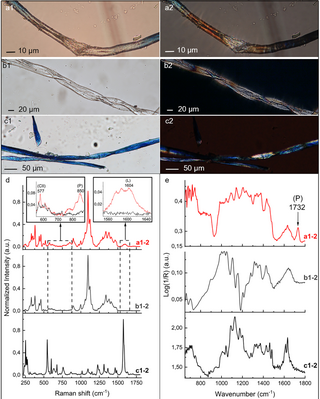Recovering evidence for the intentional use of plants in the Palaeolithic is challenging due to their perishable nature as, unlike chipped stone or bone artefacts, plant remains are rarely preserved. This has created a paradigm for the Palaeolithic in which plants seldom feature, resulting in a partial and skewed perspective; in fact, plants were as essential to human life then as they are today. Here, we combine morphological and spectroscopic analyses (µ-Raman, µ-FTIR) to provide robust multiscale physical and biomolecular evidence for the deliberate pounding and grinding of Isatis tinctoria L. leaves 34–32,000 years ago. The leaf epidermis fragments were found entrapped in the topography of the used surface of unmodified pebbles, in association with use-wear traces. Although their bitter taste renders them essentially inedible, the leaves have well-recognised medicinal properties and contain indigotin precursors, the chromophore responsible for the blue colour of woad, a plant-based dye that is insoluble in water. We used a stringent approach to contamination control and biomolecular analysis to provide evidence for a new perspective on human behaviour, and the applied technical and ecological knowledge that is likely to have prevailed in the Upper Palaeolithic. Whether this plant was used as a colourant, as medicine, or indeed for both remains unknown, but offers a new perspective on the fascinating possibilities of non-edible plant use.
“Rather than viewing plants solely as food resources, as is often the case,” explains Laura Longo, archaeologist at Ca’ Foscari University of Venice, "this study highlights their role in complex operations, likely involving the transformation of perishable materials for use in different phases of daily life among Homo sapiens 34,000 years ago.
“While research continues to improve the identification of elusive plant-derived residues, typically absent from conventional studies, our multi-analytical approach opens new perspectives on the technological and cultural sophistication of Upper Paleolithic populations, who skillfully exploited the inexhaustible resource of plants, fully aware of the power of plants.”
https://phys.org/news/2025-09-blue-indigo-year-tools-paleolithic.html


